In the late 1970s and early 1980s, Singapore Airlines operated the world’s most popular supersonic passenger airliner – Concorde – on flights between Singapore and London, as part of a joint venture with British Airways.
The service slashed flying times between Asia and Europe from around 18 hours on subsonic aircraft with multiple stops to under 10 hours, for those who could afford a ticket some 15% more expensive than a First Class fare.

Catering mainly to time-pressed business travellers, celebrities and politicians, the service was short-lived as it suffered from waning demand and rising fuel costs, leading to heavy losses.
Scratch a little below the surface though, and the story of Concorde’s time with Singapore Airlines is a fascinating one, mired in politics of one sort or another from almost start to finish.
Here’s our look back at how the history of SIA’s Concorde operation unfolded.
- Concorde in Singapore
- SIA wanted its own Concordes
- India refused overflight
- Joint venture with British Airways
- The aircraft wore both liveries
- The inaugural flight was almost scuppered
- Malaysia stands firm
- Indonesia wouldn’t commit
- 1978: Free advertising!
- Malaysia agreement
- 1979: Services restart
- The schedule
- Who flew on Concorde?
- Which crew?
- Onboard experience
- Example menu
- Further SIA services were planned
- Singapore bank notes
- First year review
- Incidents
- The end of Concorde Singapore flights
- What happened to G-BOAD?
- G-BOAD today
- The Concorde Room
- Summary
Concorde in Singapore
The history of Concorde in Singapore dates right back to 1972. On 8th June that year, thousands flocked to Singapore International Airport at Paya Lebar to watch the first Concorde land from Bangkok on its promotional sales tour.
Singapore was seen as a key stopover point for Concorde’s future ambitions to cut travel times from Europe to Australia, so the manufacturer was keen to woo the government and regulators here to ensure smooth permissions would be granted in future, even if SIA itself didn’t buy the jets.
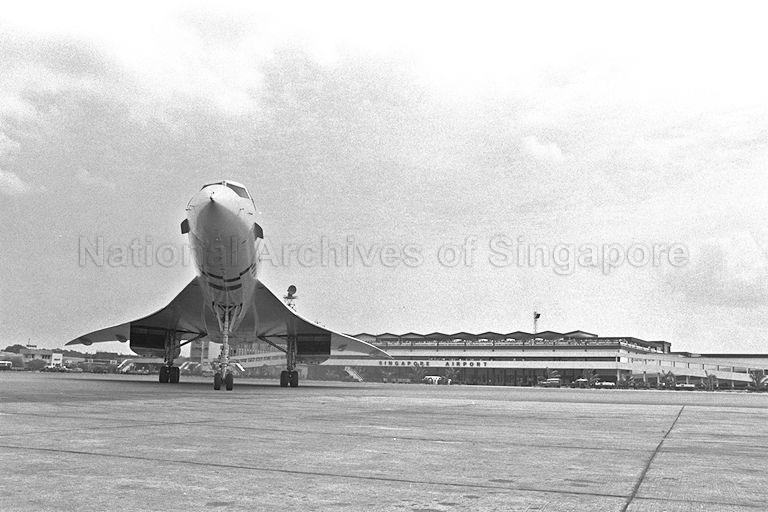
After three days in Singapore the aircraft left for Hong Kong and Tokyo, later flying to Australia before returning via Singapore once again on its way back to Europe.
SIA wanted its own Concordes
In June 1975, six Singapore Airlines cabin crew were handpicked to take part in trials by the aircraft manufacturer, simulating normal passenger service from London to cities like Beirut, Kuala Lumpur, Singapore and Melbourne.
It was a great coup for the airline to demonstrate how SIA’s renowned service could still be offered on a supersonic flight, and by September that year it was reported that Singapore Airlines was negotiating to lease two Concordes.
The proposed arrangement would start in 1977, for operation between Australia and Europe via the Lion City. Flight times between Singapore and London would be cut from 18 hours on conventional aircraft at the time to just 10 hours.
With a S$100 million price tag per jet (S$257 million in today’s money), buying the aircraft was “out of the question” according to SIA’s Managing Director Lim Chin Beng, but the carrier was said to be keen if an acceptable lease deal could be forged.
The pair of aircraft would have replaced two Boeing 747s the airline had on option for delivery in 1977 and 1978.

However, that plan never materialised.
Over a year later, in November 1976, British Airways (BA) was negotiating with the Singapore Government to start a London – Bahrain – Singapore service using Concorde, while the airline was still blocked from flying the jet to and from New York – its most desired route.
It was proposed that SIA would lease 20 out of 100 seats on each of these flights to address “the likely loss of First Class passengers” on SIA’s own London services.
India refused overflight
BA’s problems weren’t isolated to a ‘forced pact’ with SIA on a future Singapore route. It didn’t take long for politics to start getting in the way of plans to fly Concorde to and from Asia.
In the late 1970s, India refused permission for Concorde to fly over its airspace, blocking a direct routing from Bahrain to Singapore, BA’s proposed extension to an existing service.
On the table was more access to Heathrow slots for Air India, plus ‘fifth freedom’ traffic rights from the London airport, with the airline keen to tap in to the lucrative transatlantic market. In the 1970s and 80s, it was common for governments to use air traffic agreements as political chess pieces.
For those on the ground it was a different matter, creating a 100dB+ sound like an explosion.
That meant supersonic flight by Concorde was restricted to overwater or sparsely populated land masses like deserts. Even that wasn’t perfect though, with Saudi Arabia withdrawing supersonic permission for Concorde after nomads reported the sonic boom was upsetting their camels, stopping them from breeding!
Ultimately the two sides agreed to a compromise, with Concorde flights from Bahrain to Singapore having to route around the Indian mainland, adding 200 miles to the journey.
Joint venture with British Airways
By late 1977 Singapore Airlines was in negotiation with British Airways to jointly operate a Concorde on the London – Singapore route under a cost and revenue-sharing basis. The supersonic trip would cut flying time to 10 hours, with only a 40-minute refuelling stop in Bahrain.
Plans included an extension of the route from Singapore to Melbourne, Australia, though this never went ahead.
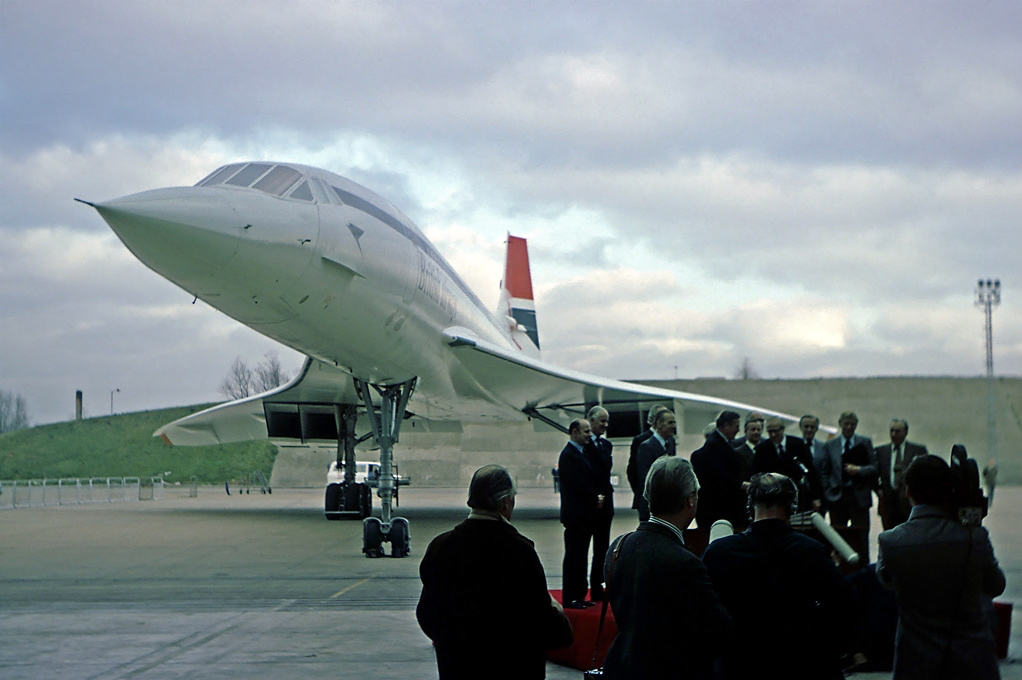
Singapore Airlines formally made an agreement for the joint venture Concorde operation with British Airways in October 1977, with the inaugural service from Paya Lebar planned for 10th December that year.
As part of the deal, SIA sent 36 of its cabin crew to London in November 1977 for training on Concorde operations.
Tickets could be purchased at BA or SIA offices and cost around 15% more than First Class fares on existing subsonic flights between the two cities.
The one-way fare was S$4,298 (around S$10,700 today) from Singapore to London and S$2,522 (around S$6,300 today) from Singapore to Bahrain.

British Airways said it needed to fill 60 of the 100 seats on board to break even, though the capacity was capped at 86 passengers when departing from Singapore due to the humid conditions affecting the aircraft’s performance.
Even with the inaugural flights fully booked, Singapore Airlines launched a global advertising campaign in December 1977, telling the world “SIA has gone supersonic”.
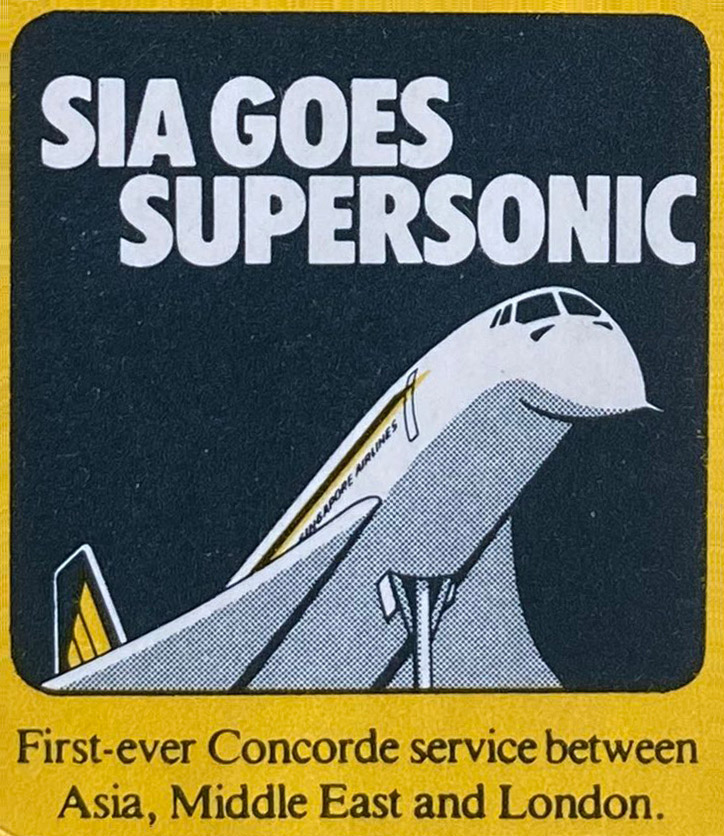
The aircraft wore both liveries
Part of the agreement between Singapore Airlines and British Airways was to operate the Concorde, registered G-BOAD (also temporarily G-N94AD), in a dual livery with Singapore Airlines titles on the left and British Airways colours on the right of the aircraft.

This became the only Concorde to fly with the colours of two different airlines, making SIA only the third airline in the world (after BA and Air France) to have its livery on the type.
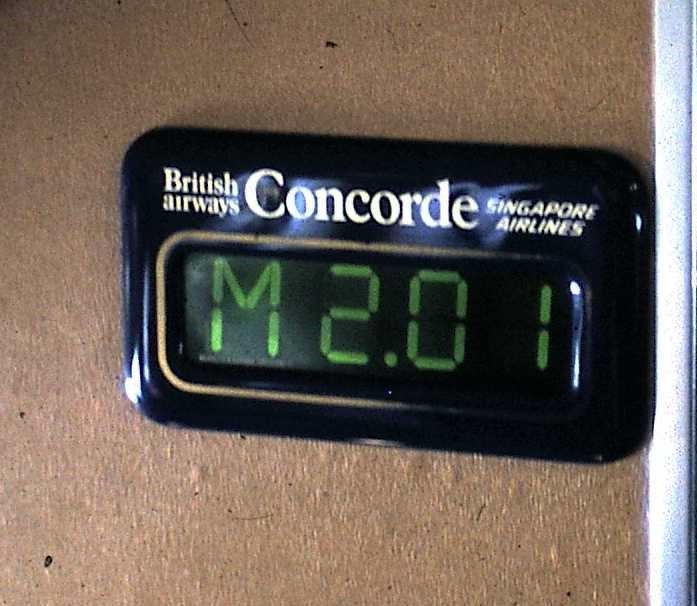
With passengers boarding via steps in Singapore in those days, into the forward left main aircraft door, it meant only the SIA livery was visible.
The inaugural flight was almost scuppered
Prior to the start of the route, there was a disagreement between British Airways and a small group of its Concorde pilots who were to be stationed in Singapore, over the terms and conditions of their detachment. This was resolved a few weeks before the first flight, but a much bigger problem was looming.
With a Concorde now adorned in Singapore Airlines colours down one side and British Airways livery across the other, and cabin crew from both carriers fully trained to jointly operate the new service, a spanner was suddenly thrown in the works.
At the eleventh hour, on 7th December 1977, the Malaysian Government threatened to hold back overflight rights for the new service. Malaysia had presented no formal reasons to deny Concorde’s overflight of its airspace, indeed the jet had previously routed over the country on demonstration flights and made several landings at Kuala Lumpur’s Subang Airport.
“We were told verbally yesterday by the Malaysian Department of Civil Aviation that overflying rights have still not been granted.
“No reasons have been given, either verbally or in writing.
“We don’t know whether this refers to supersonic or subsonic speed, but if they allow us to fly subsonic, we will do so.
“It will add several minutes to the flying time, but it is not significant.”
Ted Duggan, British Airways PR Manager for the Orient, 8th December 1977 (via New Nation)
The day before the inaugural flight was due to depart, the Malaysians formally refused all overflight permission for Concorde, subsonic or supersonic.
“The Malaysian authorities have decided to refuse permission for the Concorde flight over Malaysian airspace.”
Malaysian Communications Ministry (via The Straits Times)
No reason was given, though later a minister said they had to “look into matters affecting the people’s interests and environmental factors”.
Several newspapers in London were having none of it, stating that the “extremely puzzling” stance was “likely [because] Malaysia is piqued at the operation by Singapore [Airlines] of Concorde service”.
An aviation source said of Malaysia’s environmental reasoning “Rubbish, absolute rubbish. The problem is purely political”.
“When Britain first approached Kuala Lumpur earlier this year for permission to fly over Malaysia, the contemplated service would have been wholly British.
“But sources said Malaysia’s objections crystallised when British Airways and Singapore [Airlines] agreed to operate the flight jointly.”
Business Times, 10th December 1977
While the Malaysians were standing firm, the Singapore Government came to the rescue, striking a last-minute deal with Indonesia for the aircraft to route slightly further south than originally planned, through Jakarta’s airspace instead.
The agreement was said to have been a reciprocal gesture, following “Singapore’s support for Indonesia during a recent United Nations debate on East Timor”.
The route was saved and the inaugural flight, which had started to look as though it would have to be postponed, took off from London as scheduled on 9th December 1977, to a traditional ceremonial lion dance.
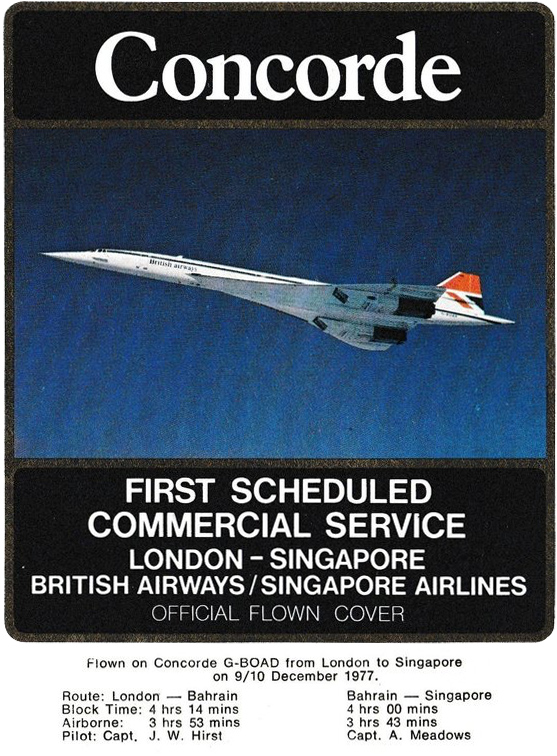
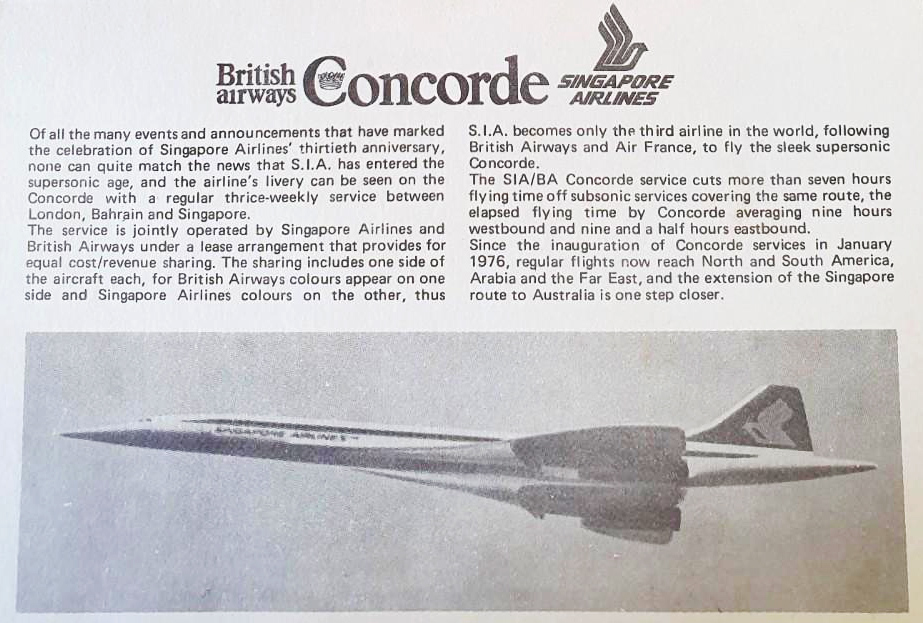
The flight touched down in Singapore at 5.35am the following morning, 25 minutes early, with Singapore Airlines cabin crew having taken over from the BA crew in Bahrain.

Only 90 passengers could be accommodated instead of the planned 100, due to the additional fuel required when taking the Indonesia routing, while only 70 passengers could travel from Singapore to Bahrain instead of the planned 86, for the same reason.

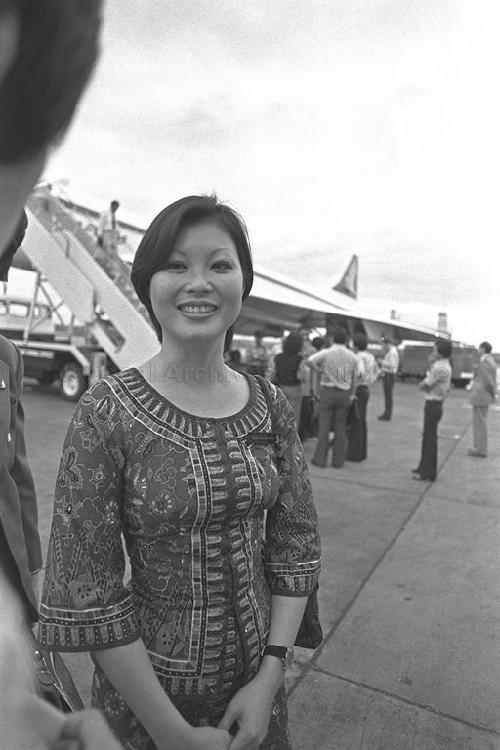
Malaysia stands firm
On 12th December 1977, the day of the second Concorde departure from Singapore to London, authorities revealed a new hiccup.
Indonesia’s overflight permission for the aircraft was only valid for one week, covering the first three flights.
That’s because the original agreement had been hammered out at a meeting between Singapore officials, British Airways and the Indonesian Directorate General of Air Communications, during an aviation conference taking place in the Lion City a few days earlier. It was therefore regarded as a temporary operational measure, valid only for a week.
Indonesian Government approval was not required, but would be needed for a longstanding agreement beyond the initial flights.
British Airways Captain Tony Meadows, who flew Concorde on its inaugural flight into Singapore from Bahrain on 10th December 1977, was dispatched to Jakarta later that day to assist British officials there “on any issue” related to the flights.
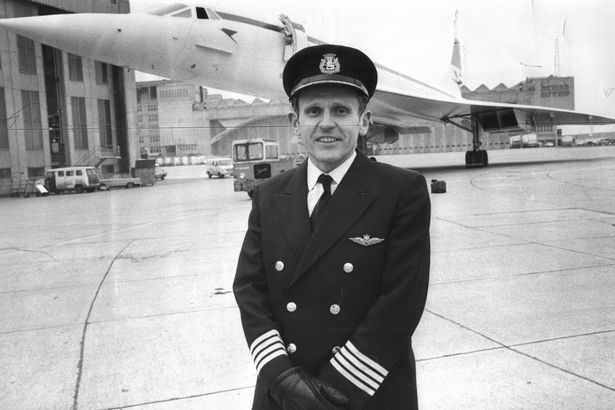
Meanwhile Gordon Davidson, British Airways Concorde Director, remained in the region rather than returning back to London as planned, and instead headed to the British High Commission in Kuala Lumpur, hopeful a deal could be struck with Malaysia to end the quagmire.
Indonesia wouldn’t commit
Not wishing to upset its friendly relations with Malaysia, the Indonesian Government was reluctant to approve further overflight permissions beyond the first three services, potentially leaving Britain and Singapore back at square one.
Striking a deal with Malaysia was seemingly the only option, though British Airways did not seem overly confident.
“If the problem is genuinely environmental, then we should certainly be able to convince them…
“If Malaysia’s decision is based on reasons of professional rivalry, however, then there is nothing we can do about it.”
British Airways official, 13th December 1977 (via Business Times)
With the third and final service blessed with Indonesian overflight approval already on its way to Singapore, last-minute talks with Kuala Lumpur were still ongoing. Indonesia said it would only approve overflight if the Malaysians also did so.
That wasn’t much use to British Airways or Singapore Airlines – they needed agreement from one or the other. The Indonesian stance meant it was all or nothing.
The fourth Concorde flight BA300 departed from London bound for Bahrain and Singapore on Friday 16th December 1977 as planned, with no one knowing whether it would be allowed to continue its journey from the Middle East.
Even with Britain suggesting a compromise ‘interim agreement’ for three months while discussions were ongoing, Malaysia then reaffirmed their refusal of overflight permission, meaning the Concorde was forced to return to London after arriving in Bahrain that night.
16 passengers who boarded in London destined for Singapore, who were reportedly “very unhappy”, were reaccommodated in First Class on subsonic flights.
Later asked why he had not intervened in the negotiations, instead leaving it to the British, Singapore Prime Minister Lee Kuan Yew said:
“If I believed that there was anything I could say or write or do that would help, I would have done so.
“There are times where there is nothing one can do better, than to do nothing.”
Lee Kuan Yew, December 1977 (via New Nation)
Fundamentally LKY was right about the issue – it really wasn’t for Singapore or SIA to get involved in what was an agreement purely between the British and the Malaysians. As the Business Times put it:
“SIA is merely the British company’s operating partner. It does not own the Concorde nor has it leased the aeroplane. The entire issue of overflying is therefore solely between Britain and Malaysia.”
Business Times, January 1978
1978: Free advertising!
With all the political obstacles for overflight permissions related to this route, it would probably have been easy for all parties involved to simply abandon the idea after these three return flights were completed.
British Airways, Singapore Airlines and their respective governments were undeterred, however, and remained fully committed to the concept. “The route will be back”, said one SIA official.
The aircraft’s dual colour scheme, with SIA livery on the left and BA livery on the right, was therefore retained in anticipation of the Singapore route’s return.
That gave SIA the unique opportunity for some lucrative free advertising during 1978, with G-BOAD fitting back in to regular BA Concorde operation around the world.
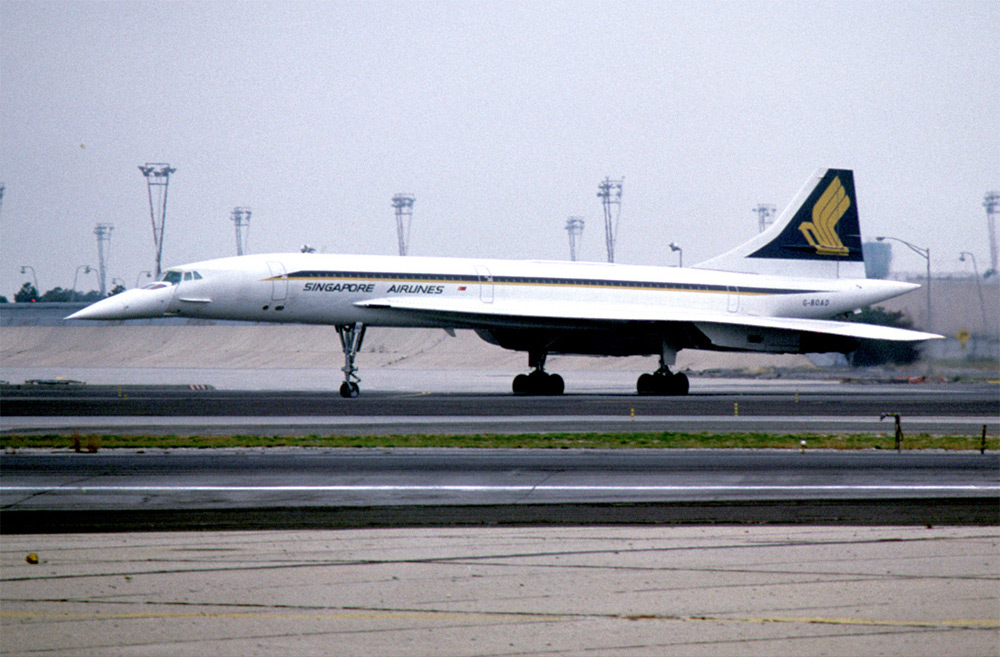
The aircraft regularly visited Bahrain, New York, Washington D.C. and Dallas on scheduled services.
There were even charter flights, including the use of G-BOAD in 1978 on a Barcelona – New York flight for the top customers of a large Spanish bank!
Malaysia agreement
After a series of talks between Britain and Malaysia throughout 1978, most of which came to nothing, a breakthrough was finally reached on 15th December that year.
“On 15 December 1978, one year after the end of the first services the Malaysian Government withdrew its objections to Concorde flights for a trial period.”
Singapore Airlines statement
Malaysian officials had finally agreed to lift the overflight ban for SIA-BA Concorde services for an initial period of six months, in what SIA’s Managing Director Mr. K. Kulasegaran described as “terrific news, quite the best I have heard for a long time”.
The decision was reached after a year-long study by Malaysia revealed “no conclusive evidence” that Concorde flights over its airspace would damage the environment. Indonesia also granted joint permission for the service to be reinstated using its airspace on the same basis.
1979: Services restart
With an agreement sealed, SQ300/301 (also operated as BA300/301) was back on, with three-times weekly flights restarted from London on Wednesday 24th January 1979 and the first Singapore – London flight operating the following day.
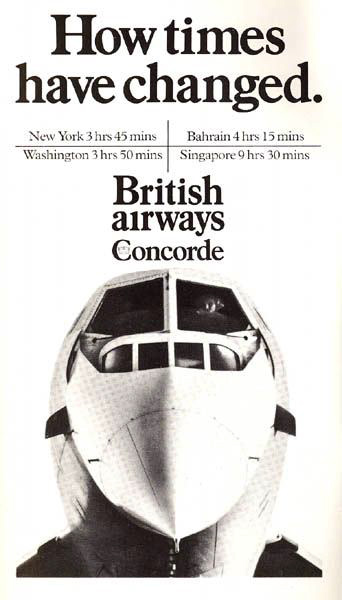
BA and SIA released a joint statement 12 days before the service restarted saying the flights would operate over Malaysia at subsonic speed for only five miles and for less than two minutes in each direction – perhaps a dig at the minor nature of what the airlines saw as an unnecessary year-long blockade.

The schedule
The dual-liveried Concorde G-BOAD was a busy aircraft, flying three times a week between London and Singapore in each direction.
Only on Tuesdays did the jet get a decent break, with 48 hours off in London for maintenance downtime from Monday afternoon through to Wednesday afternoon.
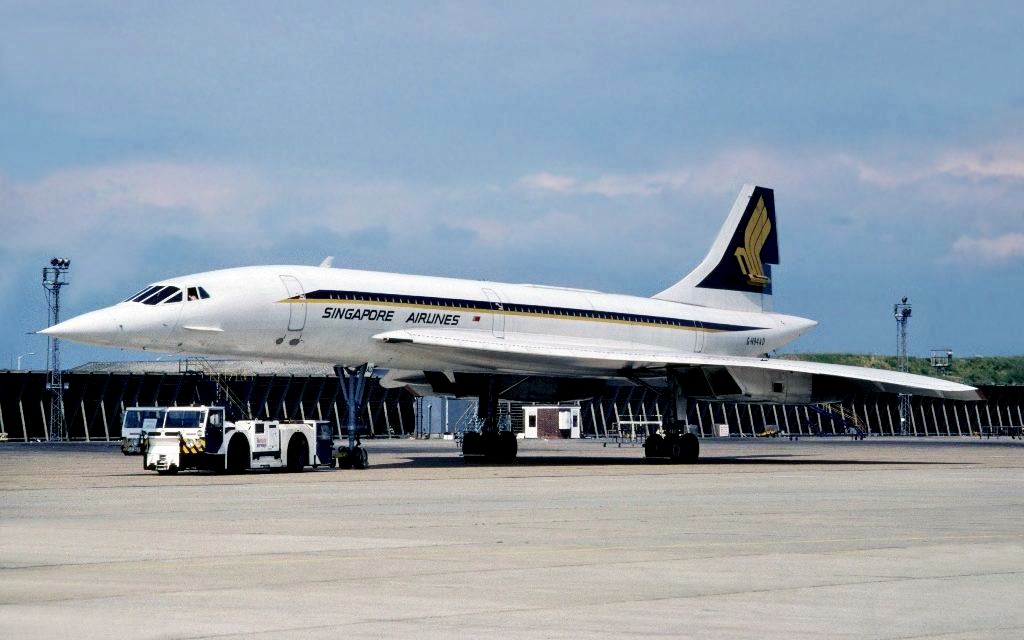
The actual service timings varied slightly during the flight’s operation, but here is an example schedule from 1979.
SIA Concorde flight schedules in 1979
| Days | |||||||||
| M | T | W | T | F | S | S | |||
| SQ301 |
|||||||||
| SIN 11:30 |
BAH 10:55 |
||||||||
| Duration: 03:55 | |||||||||
| BA301 |
|||||||||
| BAH 11:45 |
LHR 14:05 |
||||||||
| Duration: 04:20 | |||||||||
| BA300 |
|||||||||
| LHR 15:30 |
BAH 21:45 |
||||||||
| Duration: 04:15 | |||||||||
| SQ300 |
|||||||||
| BAH 22:35 |
SIN 07:10* |
||||||||
| Duration: 04:05 | |||||||||
* Next day
Actual flying time from Singapore to London was 8 hours 15 minutes, plus a 50-minute stop in Bahrain for a total time of 9 hours 5 minutes.
Flight time between London and Singapore, was 8 hours 20 minutes (9 hours 10 minutes once the stop in Bahrain was accounted for).

The aircraft used a British Airways flight number between London and Bahrain (BA300/301) and a Singapore Airlines flight number between Bahrain and Singapore (SQ300/301). Flight numbers were later changed to BA16/17 and SQ16/17.
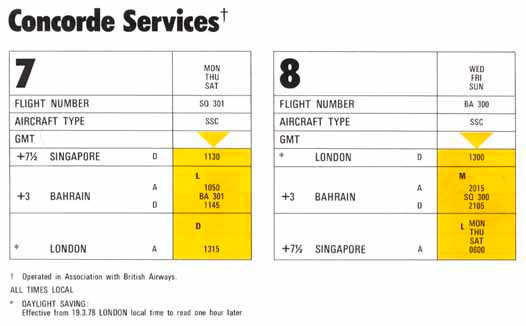
Who flew on Concorde?
A survey conduced in 1980 revealed that 17% of Concorde’s passengers on the SIN-BAH-LHR route were Singapore residents, 20% were from Australia or New Zealand and the largest group, 38%, were British residents.
Not surprisingly, 77% were travelling for business purposes, with only 18% using the service to take a holiday.
42% of passengers on the route were connecting to another city after arriving in either London or Singapore.
On 24th April 1980, Princess Margaret, younger sister of Britain’s then-Queen Elizabeth II, arrived in Singapore on the joint BA-SIA Concorde service for an official visit. The trip also included the Philippines and Malaysia, with the princess then returning to London on Concorde from Singapore on 8th May 1980.
Which crew?
The SIA Concorde was flown exclusively by British Airways pilots and flight engineers. London-based pilots flew the London – Bahrain – London flights, while the airline had a detachment of Singapore-based pilots who flew most of the Singapore – Bahrain – Singapore legs.
In both cases the pilots spent one or two-night rest periods in Bahrain while away from base.
Fun fact: When the joint venture was originally agreed, the plan included some Singapore Airlines pilots going to London for Concorde training, to operate half of the flights, however this did not materialise.For the cabin crew it was a different matter, with the flights shared between Singapore Airlines and British Airways. The two sets of flight attendants (SQ and BA) would not mix on any single flight, instead alternating on consecutive sectors.
You could therefore have an all-Singapore Airlines crew from Singapore to Bahrain, followed by an all-British Airways crew from Bahrain to Singapore, or vice-versa.
Three flight crew (two pilots and a flight engineer) and four cabin crew operated each Concorde flight.
Onboard experience
Concorde was a small plane with only 100 seats in a 2-2 configuration. It also had a low ceiling and tiny passenger windows by today’s standards, about the size of an adult hand.
Without the space of large wide-body jets like the Boeing 747, there was certainly no room for large seats or flat beds!
Instead the aircraft’s short flight time on its designed routes like London to New York meant a seat more akin to Premium Economy Class today, with the focus on speed and the distraction of fine dining to pass the little time passengers spent on board.

Indeed Concorde passengers were always generously fed and watered on any journey. Menus included vintage Champagnes like Dom Ruinart 1973 and Mumm Cordon Rouge 1975, cocktails, fine wines, caviar and lobster canapés, plus a selection of opulent main dishes.

Here’s an example lunch service on a joint SIA-BA operated Bahrain – London flight.
Bahrain – London
Aperitifs – Champagne
Canapés
Lunch
Chilled Iranian Caviar
Grilled Fillet steak with Cafe de Paris butter
Breast of duckling Montmorency
Buttered asparagus spears
Cauliflower milanaise
Croquette potatoes
Palm heart salad . Roquefort dressing
Assorted cheeses
Fresh strawberries. Double cream
Coffee
After dinner, passengers were even offered Havana cigars.
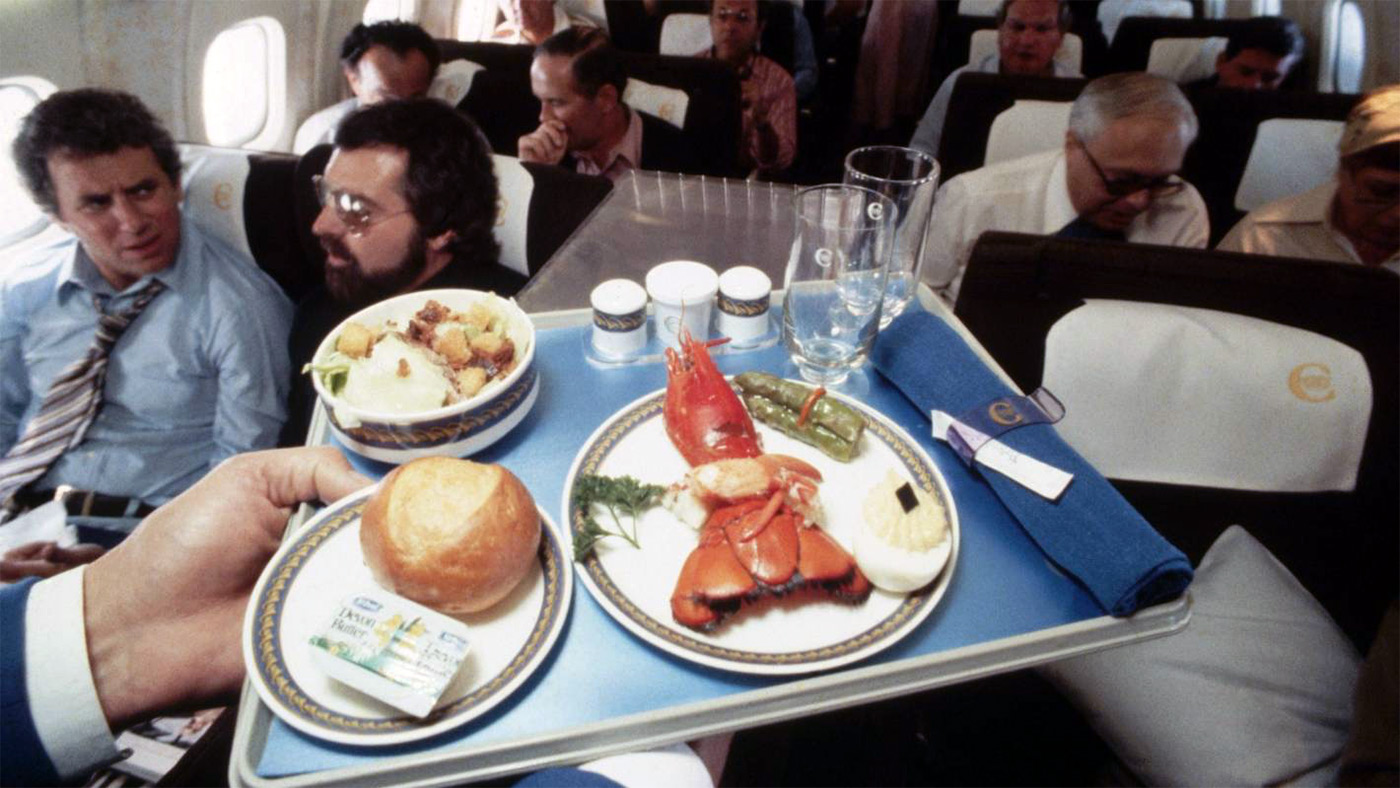
All passengers who flew on Concorde received a personal flight certificate, and the joint BA-SIA services were no exception.

The certificate would typically be handwritten and include the signatures of the Captain and other crew members.
With short flight times, Concorde was never fitted with a video in-flight entertainment system. Instead only radio programming was available.
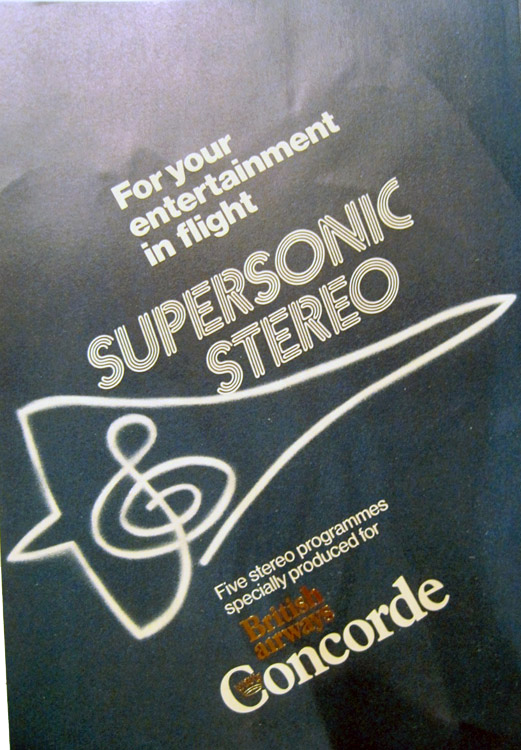
Further SIA services were planned
With the reinstatement of SIA’s London route on Concorde in January 1979, the airline was talking up future routes for the type, once they had data on how well it operated to and from London.
The Financial Times reported that “from Singapore, the possibilities for route expansion are considerable, including flights to such points as Hong Kong, Manila, Seoul [and] Japanese destinations”.
Linking Singapore to Hong Kong with Concorde would have taken only 90 minutes, while Singapore to Tokyo on the supersonic jet would have cut the flight time from 7 hours to just 3 hours.
Singapore bank notes
Having Concorde in the Singapore Airlines livery was a huge marketing point for a young, independent Singapore, and in 1979 the ‘Bird series’ of bank notes included the aircraft on the back of the $20 version.
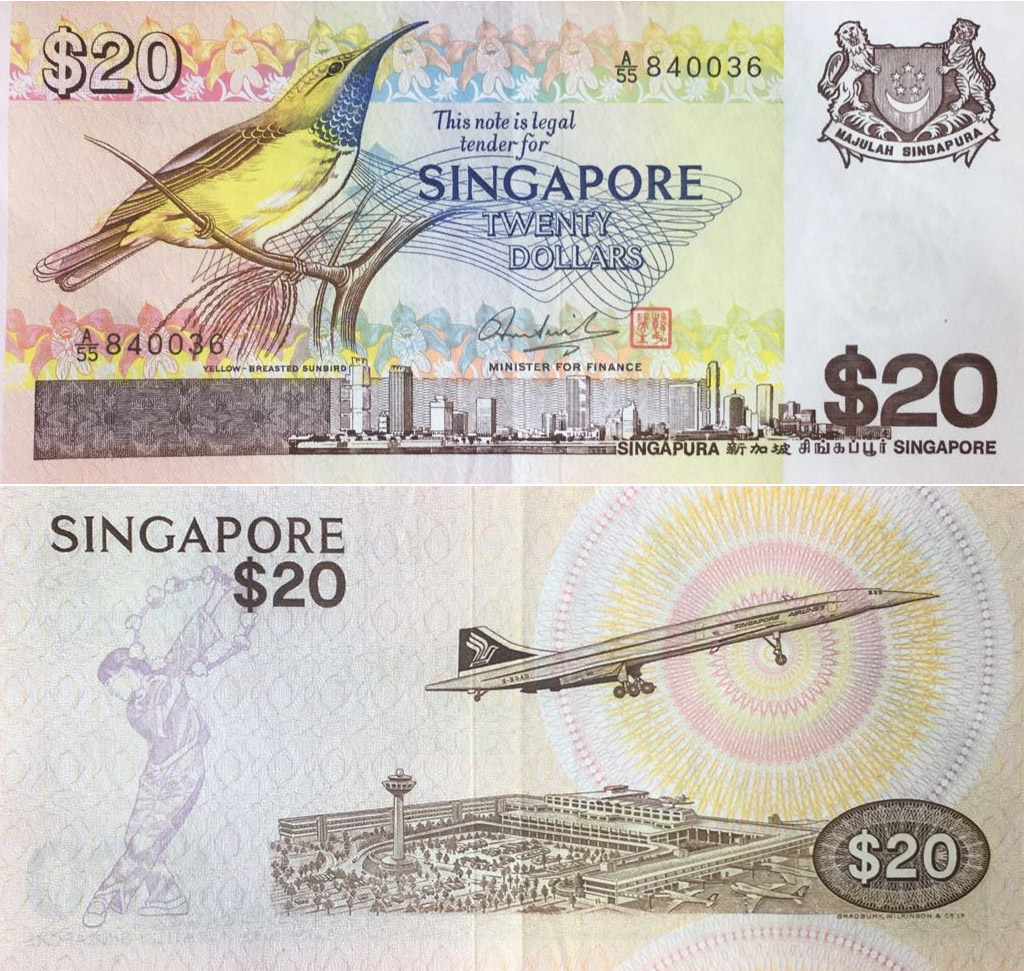
Concorde was retained on the note for a few years even after the final joint BA-SIA service departed in October 1980.
The Concorde also featured on a stamp commemorating Paya Lebar Airport after commercial flights had transferred across to Changi.
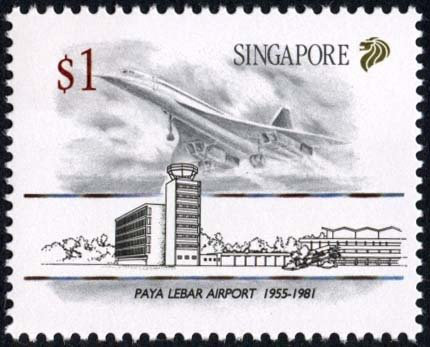
First year review
By January 1980, a year after regular Concorde services between London and Singapore had restarted, British Airways was expecting a loss of between S$14 million and S$18.5 million on the route for the January 1979 to March 1980 period, with forecasts of a similar deficit in the subsequent year.
At the time, BA was coming under increasing pressure from the new British government to turn a profit, with the state reducing its stake in the carrier.
BA executives were also said to be unhappy with the cost sharing formula they had with Singapore Airlines for the services. Despite SIA and BA sharing operating costs for the flights, including for fuel and crew, a “slide-over fee” had been agreed from the outset to account for SIA’s forecast loss of First Class traffic on its own flights.
This was said to be costing BA S$4.9 million a year, which the British carrier felt was unjustified given SIA’s recorded increase in First Class passenger numbers to and from London.
BA was also said to be unhappy with SIA’s lacklustre promotional efforts for the Concorde service, claiming it provided twice as many passengers for the Concorde flights as SIA, despite a 50-50 capacity share.
Despite the issues, SIA and BA reached an agreement to continue the services, though the “slide-over fee” from BA to subsidise SIA for its loss of First Class subsonic traffic was not reduced.
Incidents
Despite the SIA Concorde service only operating for a couple of years, there were a few ‘minor incidents’ along the way!
- On 1st February 1979 the regular London – Singapore Concorde flight was forced to divert to Kuala Lumpur, when a Singapore Airlines training aircraft burst a tyre and blocked the runway at Paya Lebar. It was only the sixth Concorde service since flights had been reinstated the previous month.
- On 31st May 1980, a Concorde flight departing from Paya Lebar on its way to Bahrain and London blew the roof off a family home. Singapore Airlines refused to pay for the damage – claiming British Airways was responsible. BA did not admit liability, but paid the family S$500 (around S$1,100 in today’s money) “to help them out”.
- On 21st July 1980, a British businessman was stabbed in the head by another passenger on a joint BA-SIA Concorde flight from London to Singapore. The SIA cabin crew and other passengers restrained the woman, who had been behaving eccentrically and did not know the man. “I still don’t know why she attacked me, I never saw her before in my life”, the man said.
- On 22nd July 1980, the same Concorde flight with the stabbed man(!) hit a flock of birds on its approach to Paya Lebar Airport, which were ingested by two of the four engines. Though the passengers on board were unaware, one of the engines was extensively damaged. A replacement had to be flown out from London, delaying the return service for 30 hours.
The end of Concorde Singapore flights
Despite an earlier agreement to continue the Concorde service, by August 1980 it became clear that not all was well.
There were reports of only 50% load factors on flights from Singapore, down from 57% the previous year, amid signs the novelty of the service was wearing off.
There were also complaints from passengers about the discomfort of the cabin compared to First Class seats on wide-body jets, with Concorde’s small seats and a much louder environment being far from ideal on a nine-hour trip.
Singapore Airlines and British Airways held further talks, amid rumours of the service now running at a S$20 million annual loss (equivalent to around S$42 million today), with rising fuel prices adding to the impact.
On 16th September 1980 is was announced that Concorde services to and from Singapore would be suspended, effective from 1st November 1980.


The final BA/SIA jointly operated Concorde service departed from Singapore on 30th October 1980. British Airways later flew all Concorde spare parts and equipment back to London.
Though no regular Concorde flights then served the Lion City, a BA charter flight from London to Singapore via Bahrain and Colombo did operate in March 1985.
French President Francois Mitterrand also passed through in September 1986, on his way back to Paris from a state visit in Indonesia, in an Air France Concorde.
These marked the types’s only two visits to Changi Airport, which replaced Paya Lebar as Singapore’s main passenger hub in 1981.
What happened to G-BOAD?
After returning from Singapore for the last time on 30th October 1980, G-BOAD had its Singapore Airlines titles removed and was returned to a full British Airways livery.
The aircraft went on to complete its service with BA, mostly to and from New York which became the airline’s ‘cash cow’ route for the type.
Here are some key facts about G-BOAD:
- 25th August 1976: First test flight
- December 1976: Delivered to British Airways
- 7th February 1996: Fastest transatlantic crossing by any Concorde LHR-JFK at 2 hours, 52 minutes, 59 seconds
- 22nd October 2003: Final passenger service
- 10th November 2003: Final flight from London to New York
- The only Concorde to ever wear the colours of two different airlines (SIA and BA)
- The highest flight time of any Concorde flown (23,397 hours)
- 8,406 flights, 7,010 of which were supersonic
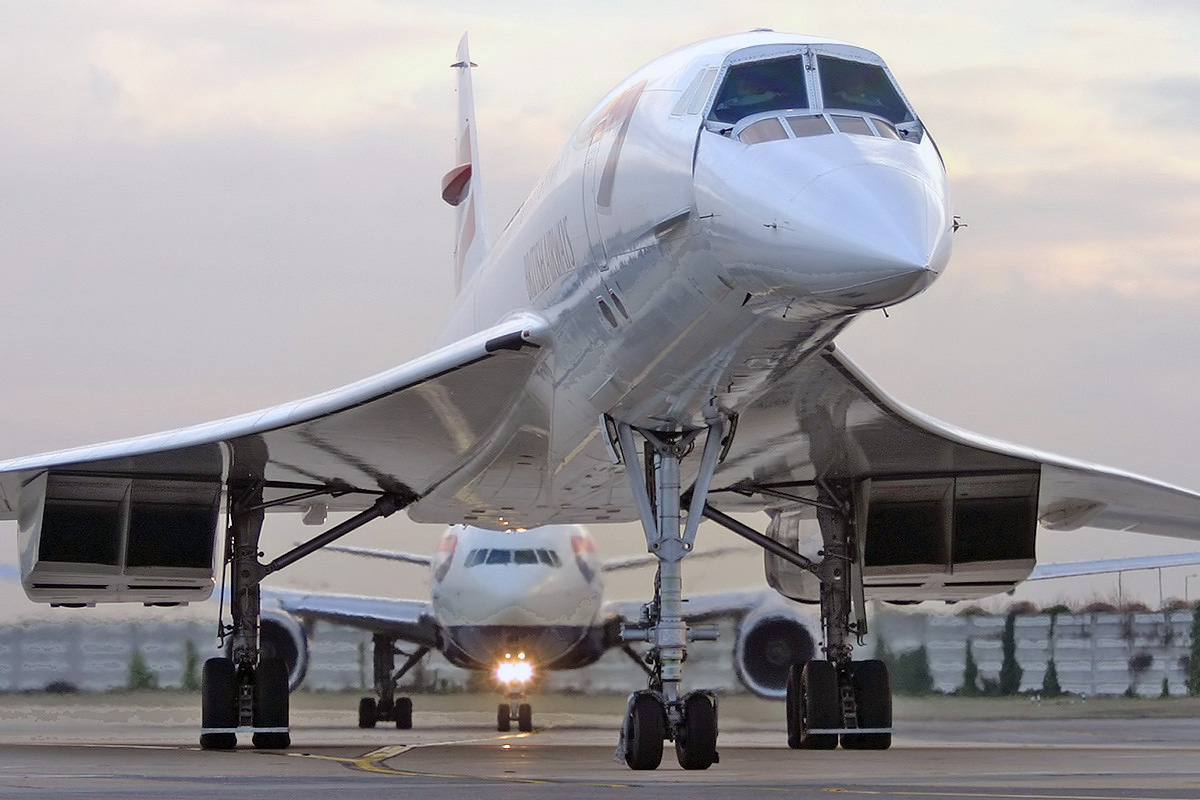
G-BOAD today
Next time you’re in New York, be sure to take a visit to the Intrepid Sea, Air & Space Museum in Manhattan.
Even if the other exhibits aren’t of interest, you can get up close and personal with G-BOAD, the very Concorde used by Singapore Airlines between 1977 and 1980.
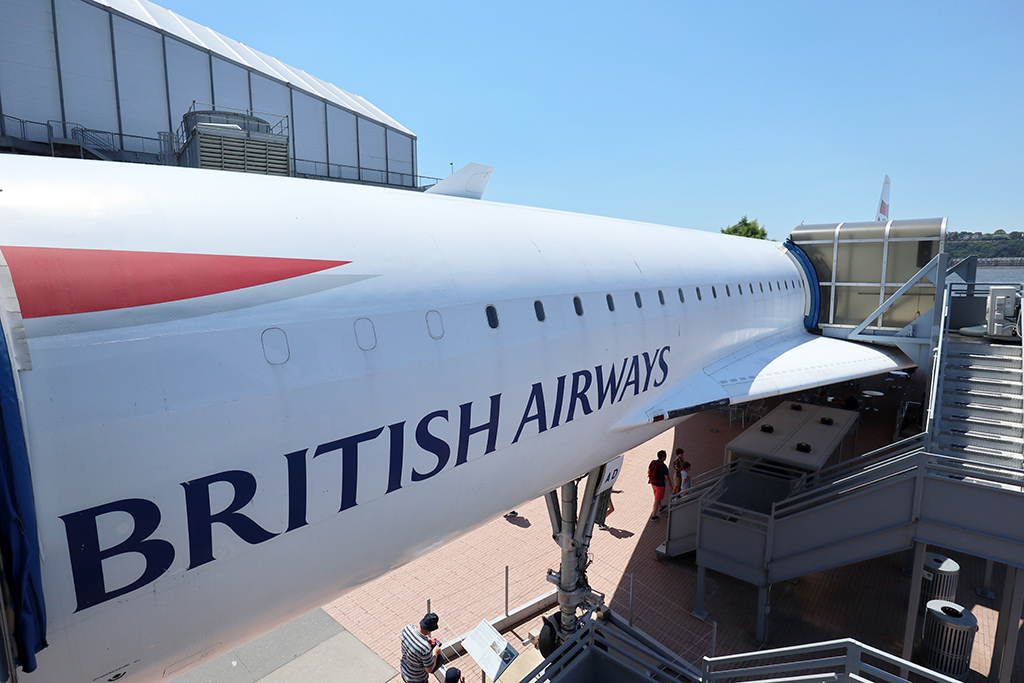
Sadly it’s still in British Airways livery on both sides (SIA would probably have had to pay this time for the advertising!).
We were lucky enough to visit during our round-the-world trip in 2018 and it’s well worth a look.
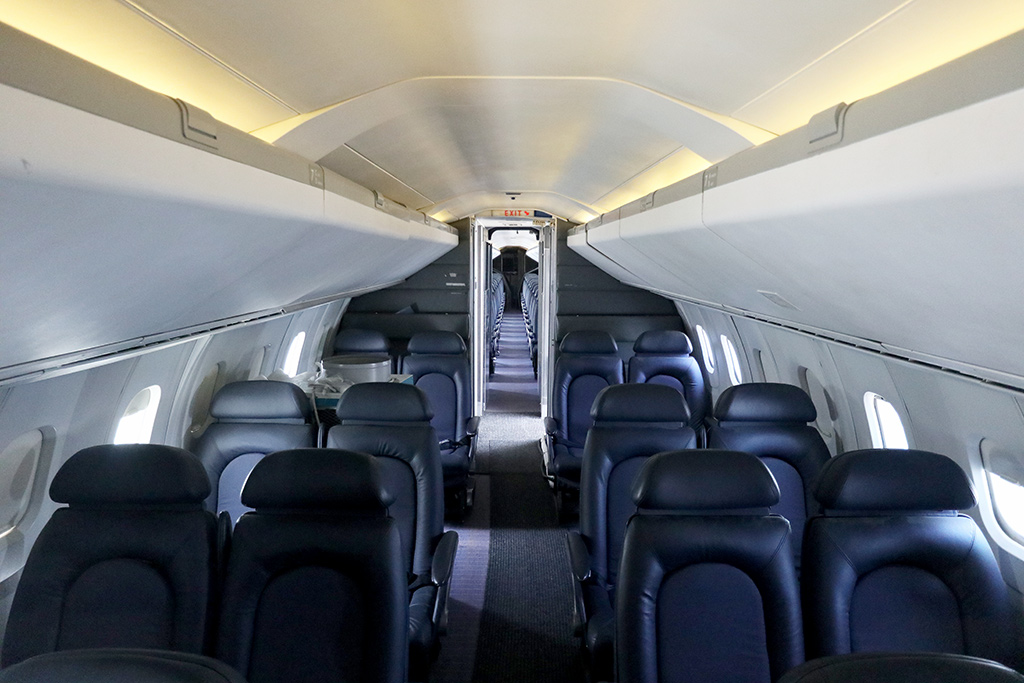
The striking features are the aircraft’s small external size (10% shorter than an A350-900) and very narrow cabin (at 2.62m wide, about the same as an ATR turboprop and less than half that of a Boeing 777).

For the AvGeeks, the flight deck is also pretty cool – a far cry from the two-crew, highly digitised cockpits of today.
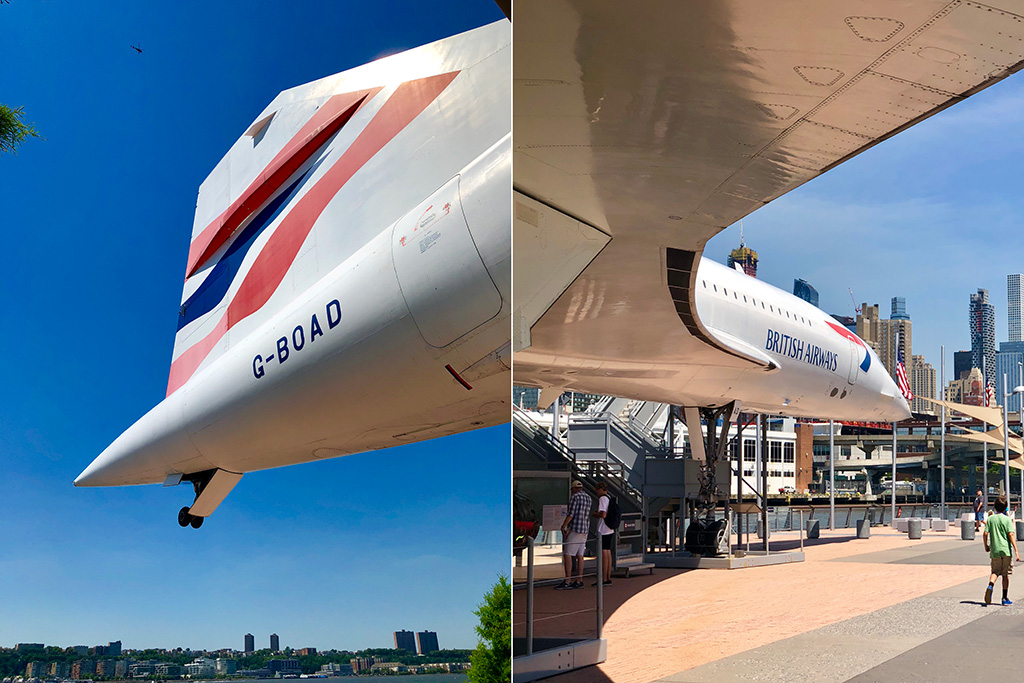
The Concorde Room
Though it’s no longer possible to fly on Concorde, the name is still used by British Airways for its most exclusive First Class lounges in London and New York. In times gone by, these lounges were reserved exclusively for Concorde passengers, with boarding directly from the lounge itself.
We passed through the London Heathrow Airport Terminal 5 facility in 2018 before flying First Class on BA to Washington, and wrote a full review of the experience.
The business centre in the lounge even features some of the old seats from BA’s Concordes.
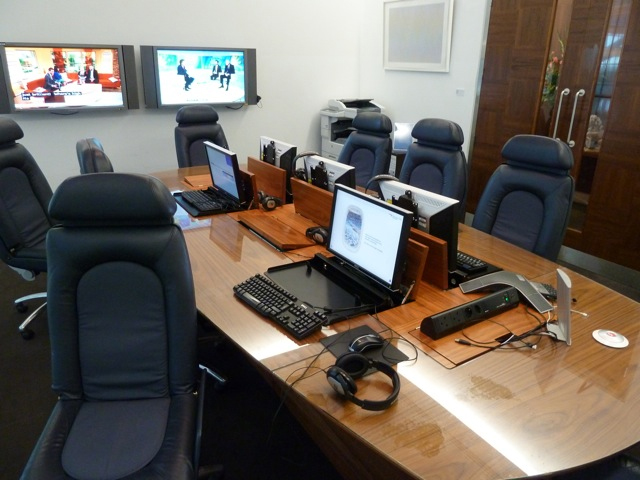
For a while the First Class section of the British Airways Singapore Lounge was called ‘The Concorde Bar’, however it has since been renamed ‘The Bar Singapore’.
Summary
As if a joint venture between Singapore Airlines and British Airways doesn’t sound fraught enough, the introduction of Concorde service in a co-operation between the two carriers became quickly mired in political disputes.
These arose from either chess games over air traffic rights, or nationalistic jealousies, though both were commonplace in the late 1970s.
By the time the service truly came to life in 1979 and 1980, jet fuel costs had soared and longer routings owing to continued overflight issues with India were continuing to make the service less and less likely to turn a long-term profit.
Sadly the last regular flight Concorde left Singapore in October 1980, closing a short but fascinating chapter in Singapore Airlines history.
Concorde later went on to become profitable on the North Atlantic between London and New York, with many passengers willing to endure the aircraft’s drawbacks for the short flight time on this lucrative city pair.
Singapore Airlines, meanwhile, can claim to be one of only three airlines in the world to have its livery adorn this rare aircraft.
(Cover Photo: Jonathan Francis)
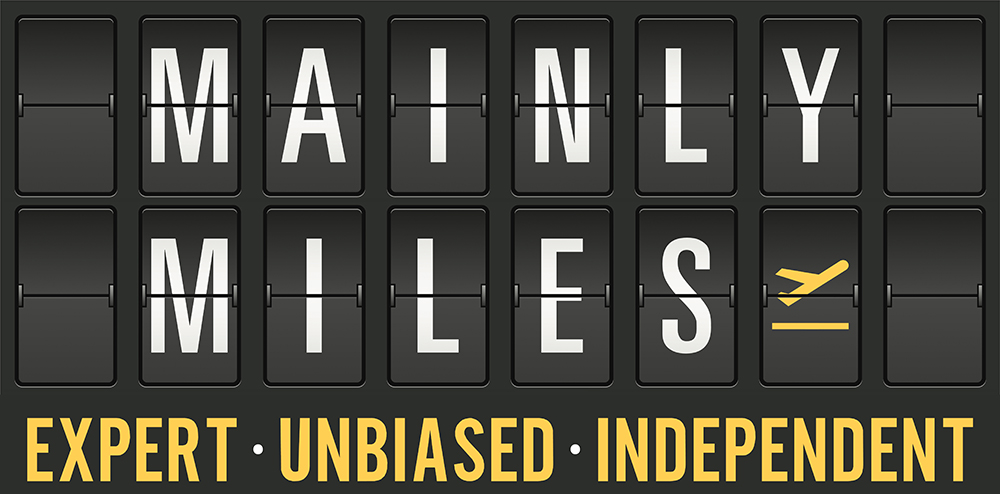
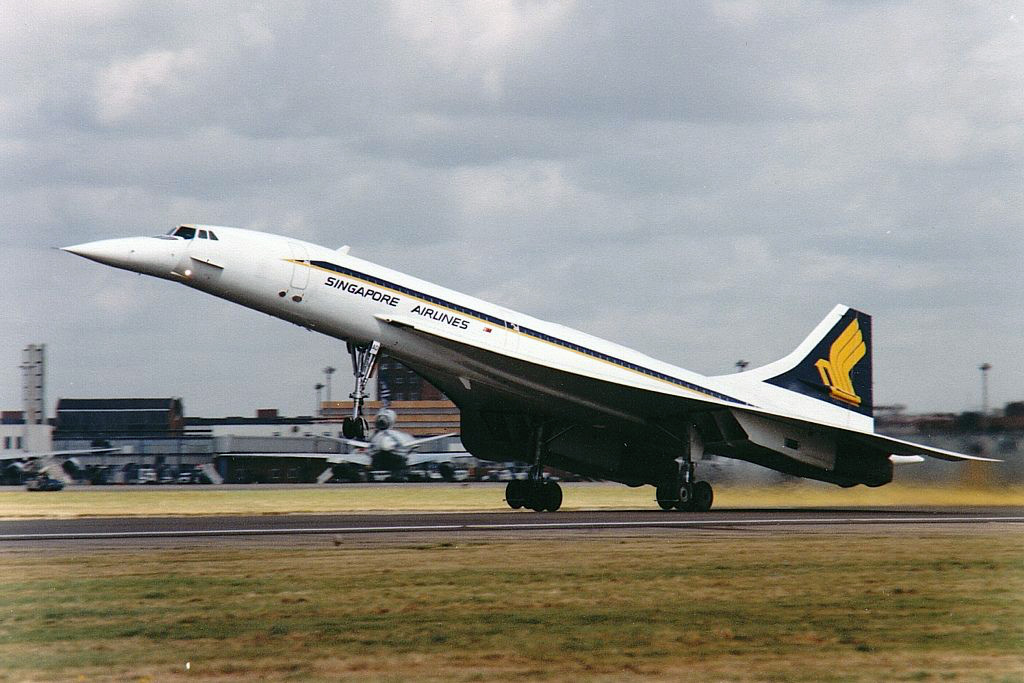

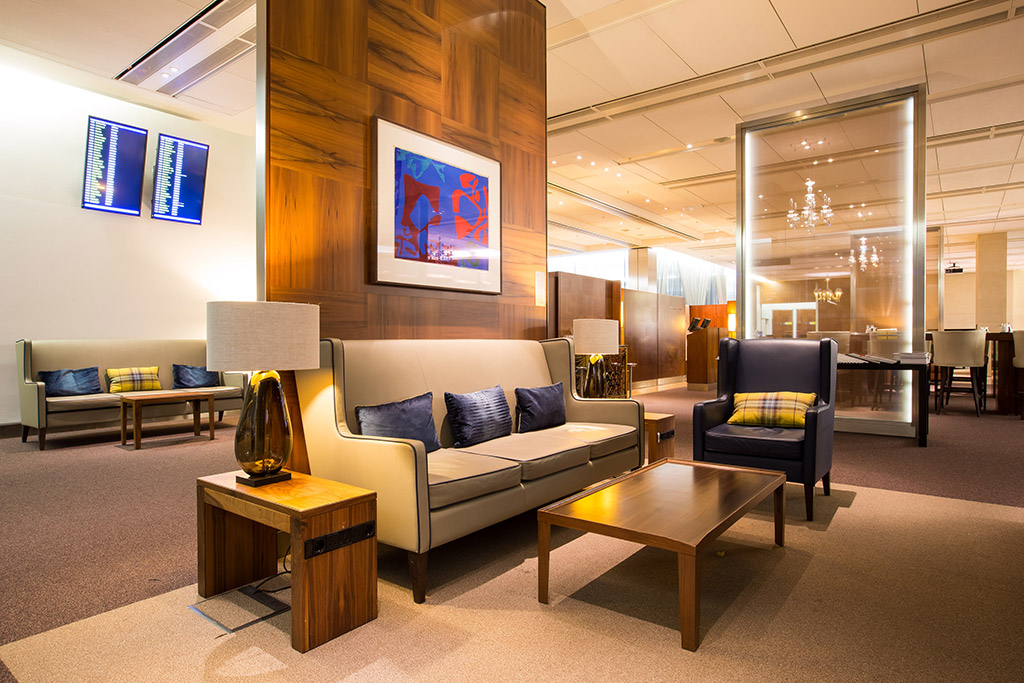
Wow… that’s an amazing piece of history you have revealed, i have been flying around 30+ years never knew that SQ even had one…. Thank you
Same here (40+ SG based and huge SQ fan)! Love the SQ history series while we are stuck. Please keep them coming! If anyone has more photos, please post!
More photos would be awesome so yes, if anyone has some please feel free to email them to me and I’ll be happy to add them in!
Thanks, glad you enjoyed it!
Thank you. It was fascinating to write and as always I learned a lot about the whole drama myself too!
Wow! Nice research & article. More please whenever you have the chance!
Thank you! Hope you enjoyed it.
Thanks Anthony!
What a wonderfully written and researched piece. I wasn’t aware that the original plan was to extend the service to Melbourne.
Love the history articles you do including the recent one on Silk Air.
Sadly with the travel restrictions from Australia it has been almost 2 years since we have been able to get back on board SIA, but have loved your website over the years and a great go to site for news on our favourite airline.
Hopefully borders open up again soon and SQ bring First Class back to Melbourne
Thanks again for such a great website
Great post, really informative and very interesting, I was aware of the SQ branded Concorde, but I’ve never read a piece so detailed specifically on the background to the arrangement, so thanks!
By far the most interesting and thorough piece I ever read on the SQ Concorde saga! Thanks
If you could afford it.add to the fact unlike the other Singapore airlines flights to London it was a one stop,all others prior to the big top 743 of 1983 and megatop in 1989 744 made some kind of milk run of two or three or four stops.qantas and British airways did the one stop thing on their jumbos at the time Concorde existed.
Thanks for the kind words, appreciate it!
The history articles are fun to research and write, but of course we’d much rather been getting on board and writing reviews!
Fingers crossed we can get back to that soon.
Thank you. What a saga indeed!
Interesting, do you know when QF and BA started one-stop LHR-SIN?
IIRC Singapore Airlines started non-stop LHR-SIN with the B743, but still needed to make it a one-stop westbound until the B744 came along?
I can answer that in relation to QF. Hope the following makes sense …
Qantas, I believe, started non stop Singapore to London services in October 1989. QF9 operated SYD-MEL-SIN-LHR some days of the week. Eventually it built up to daily, and the SYD-MEL leg eventually ended.
Prior to then, Qantas had only offered one stop services to London from Australia via Mumbai (April 86 to October 87) and via Bangkok (from October 87 to October 88). Both flights used the QF9 and QF10 flight numbers.
In October 1988 Qantas shuffled its European flights. QF1 became a daily MEL-SYD-BKK-LHR flight, while QF9 became a MEL-SYD-SIN-BAH-LHR flight with occasional variations for the next year, until the start of non stop Singapore to London flights in October 1989 mentioned above.
And one stop services (via Bahrain) started in 1977 (possibly late ‘76). QF1 moved to daily MEL-SYD-SIN-BAH-LHR in October 1980.
That might have been your original question!
Fantastically researched, really enjoyed this.
Awesome write up Andrew! 🔥🔥
My mother was working for Singapore Airlines in Taipei then. At a high level, I remember SIA’s Concorde history quite well, but I didn’t know the reasons behind Malaysia’s refusal and why the Indonesian overflight was only temporary. So, thank you for the more detailed history..
I still have the promotional “SIA goes Supersonic” stickers with me (but airplane on the sticker was incorrectly depicted with SIA’s logo on the starboard side).
I’d love to see those stickers if you’re happy to share them Andrew!
I did on Twitter.
Andrew, is your mother Sophie? I was a SQ Cabin Crew.
This is such a well-researched article!!! Thanks so much for the educational lesson!!
And what a pleasant surprise at the end – I visited the Intrepid Museum in NY in 2014 and the Concorde, not knowing it was the actual one SIA flew (in the days before I was born)
I loved reading this!! Thank you!!
Thanks for the kind words, I’m glad you enjoyed reading it!
I am obviously biased but I was a little disappointed that there is only a short reference to G-BOAD’s ‘half service’ with SIA at the Intrepid display. I think they could have said a bit more about it.
Here is a picture of actual SIA service on board the concord from this instagrammer – Joanday 777 (who incidentally posts a lot of nostalgic pictures of air travel from yesteryear, including from SIA):
https://www.instagram.com/p/CQFqAAiByyC/
Such a good history v.well researched!
I wonder do you know how much fuel Concorde burn? People say it was very inefficient but I never saw numbers.
Concorde was a real gas-guzzler! It burned about 80,000kg of fuel flying from Singapore to Bahrain and the same again from Bahrain to London, so about 160 tonnes of fuel in total in each direction.
Today, an Airbus A350 makes non-stop Singapore – London flights using about 65 tonnes of fuel, just 40% of what Concorde burned, before you even account for the fact it carries 250+ pax not 100!
Thanks I added details of Princess Margaret’s visit to the article.
Great article. I worked in KL at the time and once could have flown in it, but chose something else. So regret that decision. Never again had that chance. I did get to see it at least during a visit to Singapore. Princess Margaret flew Concorde to Singapore for a Royal visit in the early 80s.
i didn’t know any of this …,very interesting as I have an attachment to both Singapore (lived there 5yrs) & Concorde (lived at Fairford during 002 testing)
Well written article and wonderful photos! Thank you for this exquisite journalistic contribution to aviation history!
Well put together Andrew, and greatly appreciated as a fascinating read and account of some unique history. Keep up the great work!
G-BOAD was not the only Concorde to fly in 2 airline colour schemes. Concorde 02 (F-WTSA), the first to be built with the physical appearance of the production aircraft, was painted with the BA livery (Negus & Negus scheme) on the left-hand side and AF (shark fin scheme) on the right-hand side. Granted it did operate in commercial service, but it did have 2 airline colour schemes applied.
Thanks Richard I wasn’t aware of that!
There was a mention of “in what SIA’s Managing Director Mr. K. Kulasegaran described as “terrific news, quite the best I have heard for a long time”.
Mr Kulasegaran was not SIA’s MD. He was the Director of Finance.
Thanks – apparently in December 1978 Kulasegaran was acting Managing Director of SIA, according to the Business Times reference.
No doubt a temporary position, but it did effectively make him the MD at the time.
In a sad twist of irony, Captain Tony Meadows who was mentioned in this piece, his life took a tragic turn a few years ago when he took his and his wife’s life when confronted with the future of their deteriorating health. Article here: https://www.bbc.com/news/uk-england-berkshire-55071504.amp
My goodness, that is terribly sad.
Fantastic article, wonderfully researched, brilliantly illustrated, and although a bit of a tangent from the usual content it was a story I had never heard about before. Such a shame that I didn’t get to read it before I travelled to NYC a couple of months back, where I visited the Intrepid museum! Declined the Concorde visit as it was a long queue, a very hot and sunny day, and I’ve been on the Duxford Concorde in the UK. Now feels a shame.
When I was kid I got to go on one of the concords parked at Heathrow (my dads brother worked for security ) we were on holiday’s from Canada. A few years later my dad and i went to NewYork to take pictures of aircraft at JFK, was awesome and I was able to take a pic of the concord with the SAI colours.Great write up!!!
Dear Andrew, really well written and a wonderful showcase of an interesting time in SIA’s history.
Please google “Diamonds in the Sky” documentary from 1979/80 which can be found on YouTube — quite a bit of footage of SIA at the time spread across the seven episodes (apparently SQ was THE trendsetter at the time, more so than any carrier today) as well as inflight footage of the SQ crew serving Concorde!
Once again well done!
Great article of a unique aircraft. It was on this day (27th April) in 1978 that my wife and I took the flight from Bahrain to Heathrow. I have some scans of old negatives of our trip, including a picture of the flight deck. We’ve kept all the items we were given on the trip, plus a salt and pepper pot and two glasses we were allowed to take away.
Wow what a fantastic experience and great memory.
Do let me know if you have any images you’re willing for me to include in the article!
My parents flew that plane from Singapore to Bahrain, sometime between 1979 and 1980. We still have their flight certificates, signed by the captain.
Concorde Room JFK closed last year when BA moved to T8 there and opened joint lounges with American Airlines in that terminal.
I remember i was at Paya Lebar airport early in the morning for its inaugural arrival flight.Parked right in front of the viewing gallery.Stayed until the departure too.
I have the SQ Concorde menu and some other stuff a friend of my father’s who flew on it.
In 1984 i joined SQ as a cabin crew and we had a steward who did his retraining with us because he was grounded and he was one of the few who operated on the Concorde.He told us alot of stories.
Good times.
I was working out of Tokyo in 1979 covering most of Asia. My younger brother, living in England was to get married August 18 whilst I was on business in S E Asia so I asked my Japanese secretary to get me a Spore-London-Singapore leg at my expense. Usually flights to London on widebody aircraft left Spore in the late evening in 1979 but my secretary found me a nice flight leaving around noon August 16. Being busy I never checked the itinerary and turned up at Spore airport only to find out she had booked me on the Concorde flight via Bahrain. Too late to change I proceeded to board on a most exciting and costly flight! I still have the certificate signed by the captain, John Massey. One of the more interesting experiences of my life.